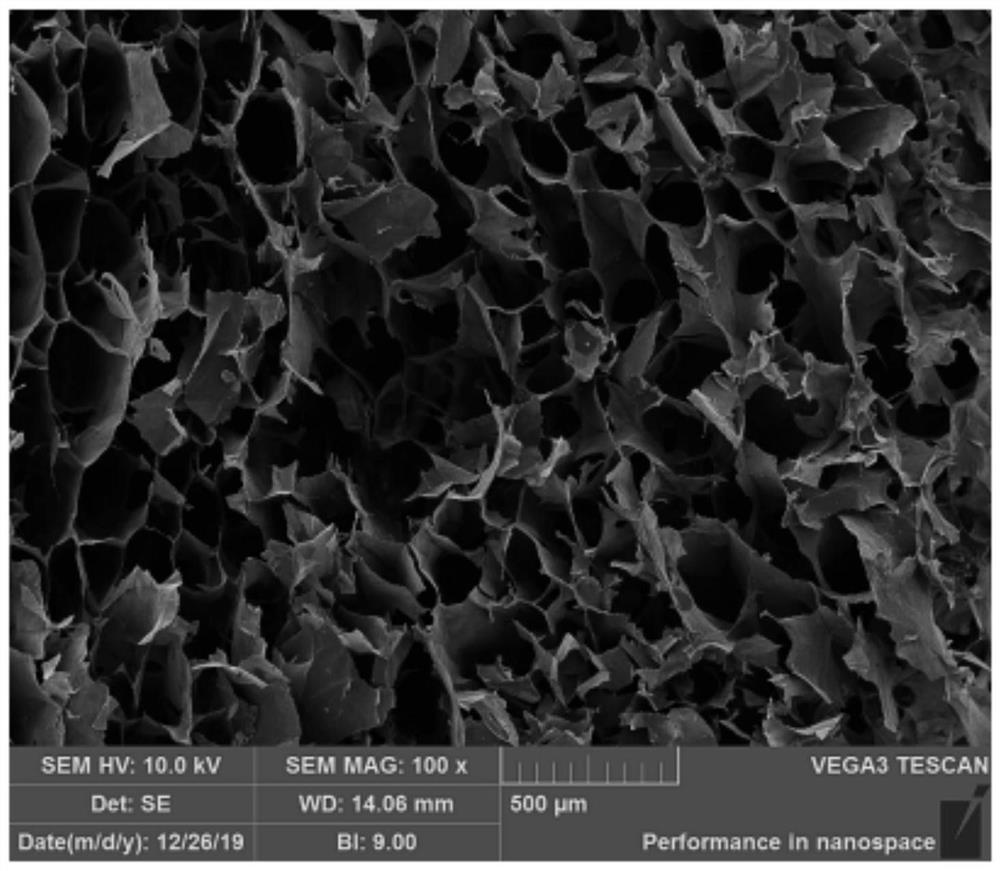Preparation method of cellulose nano-fibril aerogel suitable for layer-by-layer self-assembly process
A layer-by-layer self-assembly and nanofibril technology, applied in the field of aerogels, can solve the problems of reduced utilization, easy agglomeration, and inability to achieve nano-level scale control, and achieves high wet strength, high surface charge, good The effect of shape stability
- Summary
- Abstract
- Description
- Claims
- Application Information
AI Technical Summary
Problems solved by technology
Method used
Image
Examples
preparation example Construction
[0019] The preparation method of the cellulose nanofibril airgel applicable to the layer-by-layer self-assembly process of the present invention, the steps are as follows:
[0020] 1. Ultrasonic dispersion of cellulose nanofibrils (CNF) produced by TEMPO oxidation into water to obtain a 1wt% cellulose nanofibril dispersion;
[0021] 2. Dilute polyethyleneimine (PEI) aqueous solution with a molecular weight of 70000 to 15%;
[0022] 3. Mix the cellulose nanofibril dispersion obtained in step 1) with the polyethyleneimine aqueous solution obtained in step 2) at a mass ratio of 1:2 to 2:1, disperse it evenly, and let stand to obtain the structure Stable CNF hydrogel;
[0023] 4. Pre-freeze the CNF hydrogel obtained in step 3), and then freeze-dry to obtain the CNF aerogel suitable for the LBL process.
[0024] In order to better understand the steps of the above preparation method, it is described in detail.
Embodiment 1
[0026] A method for preparing a cellulose nanofibril aerogel suitable for a layer-by-layer self-assembly process, comprising the following steps:
[0027] 1) Ultrasonic dispersion of cellulose nanofibrils (CNF) prepared by TEMPO oxidation into water to obtain a 1 wt% cellulose nanofibril dispersion. Among them, the cellulose nanofibrils (CNF) prepared by the TEMPO oxidation method were purchased from Tianjin Wood Spirit Technology Co., Ltd. The obtained nanocellulose has a diameter of 5-20 nm and a length of 1-5 μm.
[0028] 2) Dilute polyethyleneimine (PEI) aqueous solution with a molecular weight of 70000 and a concentration of 50% to 15% with deionized water.
[0029] 3) Control the mass ratio of CNF dispersion liquid to PEI aqueous solution to be 1:1. Specifically: after mixing 30 mL of the cellulose nanofibril dispersion (CNF dispersion) obtained in step 1) with 2 g of a polyethyleneimine aqueous solution with a concentration of 15% obtained in step 2), stir rapidly wit...
Embodiment 2
[0034] A method for preparing a cellulose nanofibril aerogel suitable for a layer-by-layer self-assembly process, comprising the following steps:
[0035] 1) Ultrasonic dispersion of cellulose nanofibrils (CNF) prepared by TEMPO oxidation into water to obtain a 1 wt% cellulose nanofibril dispersion. Among them, the cellulose nanofibrils (CNF) prepared by the TEMPO oxidation method were purchased from Tianjin Wood Spirit Technology Co., Ltd. The obtained nanocellulose has a diameter of 5-20 nm and a length of 1-5 μm.
[0036] 2) Dilute polyethyleneimine (PEI) aqueous solution with a molecular weight of 70000 and a concentration of 50% to 15% with deionized water.
[0037] 3) Control the mass ratio of CNF dispersion liquid to PEI aqueous solution to be 1:2. Mix 30mL of the 1wt% cellulose nanofibril dispersion obtained in step 1) with 4g of a 15% polyethyleneimine aqueous solution, stir rapidly with a magnetic stirrer for 2 hours to disperse evenly, and then let it stand for mo...
PUM
| Property | Measurement | Unit |
|---|---|---|
| diameter | aaaaa | aaaaa |
| length | aaaaa | aaaaa |
| density | aaaaa | aaaaa |
Abstract
Description
Claims
Application Information
 Login to View More
Login to View More - R&D
- Intellectual Property
- Life Sciences
- Materials
- Tech Scout
- Unparalleled Data Quality
- Higher Quality Content
- 60% Fewer Hallucinations
Browse by: Latest US Patents, China's latest patents, Technical Efficacy Thesaurus, Application Domain, Technology Topic, Popular Technical Reports.
© 2025 PatSnap. All rights reserved.Legal|Privacy policy|Modern Slavery Act Transparency Statement|Sitemap|About US| Contact US: help@patsnap.com



